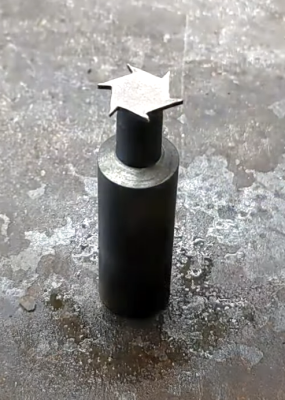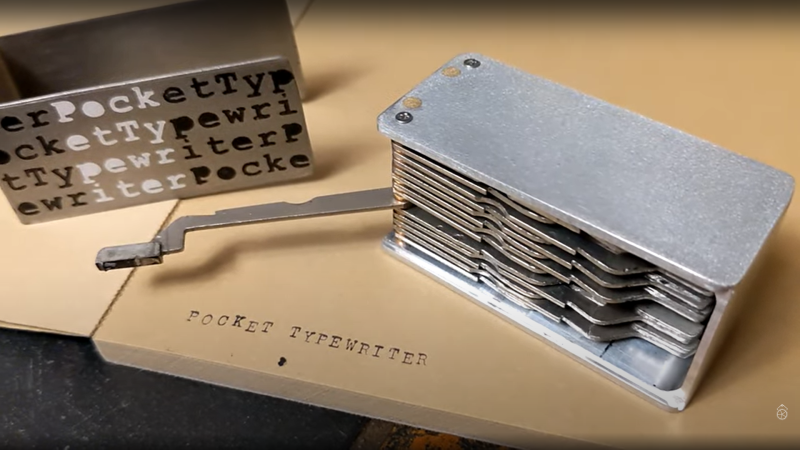
[Attoparsec] wondered what if you could carry a typewriter in your pocket, then followed through with that and built one. (Video, embedded below.) Kind of. The plan was to use an existing set of striker bars, but not wanting to destroy a perfectly good typewriter, they realised that you can easily source just the bar set on eBay.
The first problem was that the striker bars are shaped to allow the typewriter mechanism to operate, but that would not make for a compact arrangement. After a spot of straightening in a big vice, and drilling in a custom jig, they were in a suitable state to be arranged inside the case. The casing is milled from a chunk of aluminium, complete with a nice recess to hold an ink-impregnated felt pad. To prevent this pad from drying out when stowed, and to keep the whole thing clear of pocket lint, a U-shaped metal cover was bent from some sheet. This slides into a set of slots that are milled near the edges, in a very satisfying manner. This last bit was causing them a little trouble, so a custom slotting tool was created especially for the job. And a good job was indeed done. The final results look as you might expect from a manual ‘typewriter’ quirky, a bit wonky, but fabulous all the same.
If you have an old typewriter that needs some attention, here’s a quick guide for giving it a once-over. Some of you of a certain age may remember electronic typewriters with some fondness. They died a rapid death, but if you’ve still got one lurking, you could convert it into a Linux terminal for some clackity nostalgic fun.
Thanks to [smellsofbikes] for the tip!

















I had a portable electric typewriter abiut 1976. It was a small suitcase. But better than the one I had as a kid, where you turn the knob to get the letter, then oress the keyboard, the whole thing, to print the character.
I remember a toy typewriter from the 1950’s. The type was on a wheel, like a Dymo labelmaker or daisywheel printer. You laid the piece of paper on the table, and sat the typewriter on top of it.
When you pressed a key, it mechanically rotated the wheel to the desired letter. Then when the key was fully depressed, a spring banged it against the paper.
When you released the key, little rubber tires shifted the entire typewriter slightly to the right, ready for the next character. At the end of the line, you had manually re-position the typewriter on the paper for the next line.
The whole contraption was about 7″ wide, 4″ high, and about 2″ thick. Too small to fit in a pocket, but a lot smaller than a “real” typewriter.
They cheaped them out in the 70s, you only had the one key for the strike action and had to rotate the daisywheel yourself for each letter.
So it’s a set of stamps in a nice allen wrench-style carrying case. Kinda cool. The really cool part is all the custom machining skills.
I wonder what the significance of “attoparsec” is. 3 centimeters?
The ridiculousness of an extremely small part of an extremely large number, I think.
Got excited then watched the video. All this is is an admittedly slick looking Swiss army knife kind of thing holding typewriter arms. Typewriter is a massive misnomer. More like embosser or something. I have a set of number/letter punches for marking metal parts that would do the same thing. Even taking one of those manual rotary label maker things and just inking it would be better.
Also snickered at “ruining a perfectly good typewriter” when the running joke on HaD is take some vintage gear, gut it, put in an arduino and call it a day.
So did he lay out the striker bars in his swiss army typewriter in a Qwerty or Dvorak layout?
I enjoyed the video. Very little “fluff” to make me wonder if I was wasting my time.
The art and skillset involved with toolmaking is awesome! Despite sometimes the obvious usefulness of certain tools, the challenge and experience still remains.
Speaking of tiny typewriters, I was very sorely tempted the other day in a thrift, had a real dinky little Brother machine, must have been one of the EP series, with LCD screen for word processing, or at least line at a time editing, looked just a little fatter than one of those Epson HX20s, and potentially more useful if you needed output in a hurry. Had the plastic guard missing, and looked a little knocked up, or I’d own it now I guess, since I could find reasons to leave it.
Huh. Makes me want to assemble something that’d do a sort of stamping operation with a Selectric ball. Like, you’d set the guides down where you want to start “typing”, and rotate the ball into position for the right character — probably with little detents in the mechanism to soft-lock a character, and a stylus pointing to the layout on the back end so you could steer — and you’d press down, a roller would ink the stamp, it’d press into the paper, and the guides would shift sideways just a bit to set up the next character.
Now I type it out, it sounds wildly overcomplicated. Which is not necessarily a reason not to do something, but I assuredly don’t presently have the required machining skills.
“The plan was to use an existing set of striker bars, but not wanting to destroy a perfectly good typewriter, they realised that you can easily source just the bar set on eBay.”
So basically someone else destroyed a perfectly good typewriter for them.
I love how he made his own slitting saw & heat treated it, even though its easy to buy the size he needed. Shows how fun and straightforward toolmaking can be. Excellent post
Pocket typewriters, particularly in an early era, were actually produced, especially index typewriters that had no keyboards. This pocket machine, for example, attempts to also handle alignment and movement on regular paper: https://typewritermuseum.org/collection/index.php3?machine=indexpocket&cat=ic# . Some other pocket typewriters instead wrote on small tapes.
“Less than 10 cms long and boasting a weight of 4.5 Oz (120 grams) it must have been a great salon conversation piece, equivalent to today’s palmtop computer.“
I actually collect, repair and regularly use manual typewriters. It’s a fascinating hobby. The precision machining that went into them is stunningly elegant, even for the lower-end machines. My current desktop machine is an 1956 Olympia SG1. It weighs about 45 lbs, it has every bell and whistle a typist could want, a cursive typeface, and it’s an absolute dream to type on. The keys have a spring assist that reduces the amount of pressure that you need to apply to get a good impression on the paper. I use it daily for lesson plans, worksheets, task lists, letters, writing for pleasure, etc. Typing never fails to relax me and focus my writing. I don’t get that same vibe from a computer, at least when I am writing.